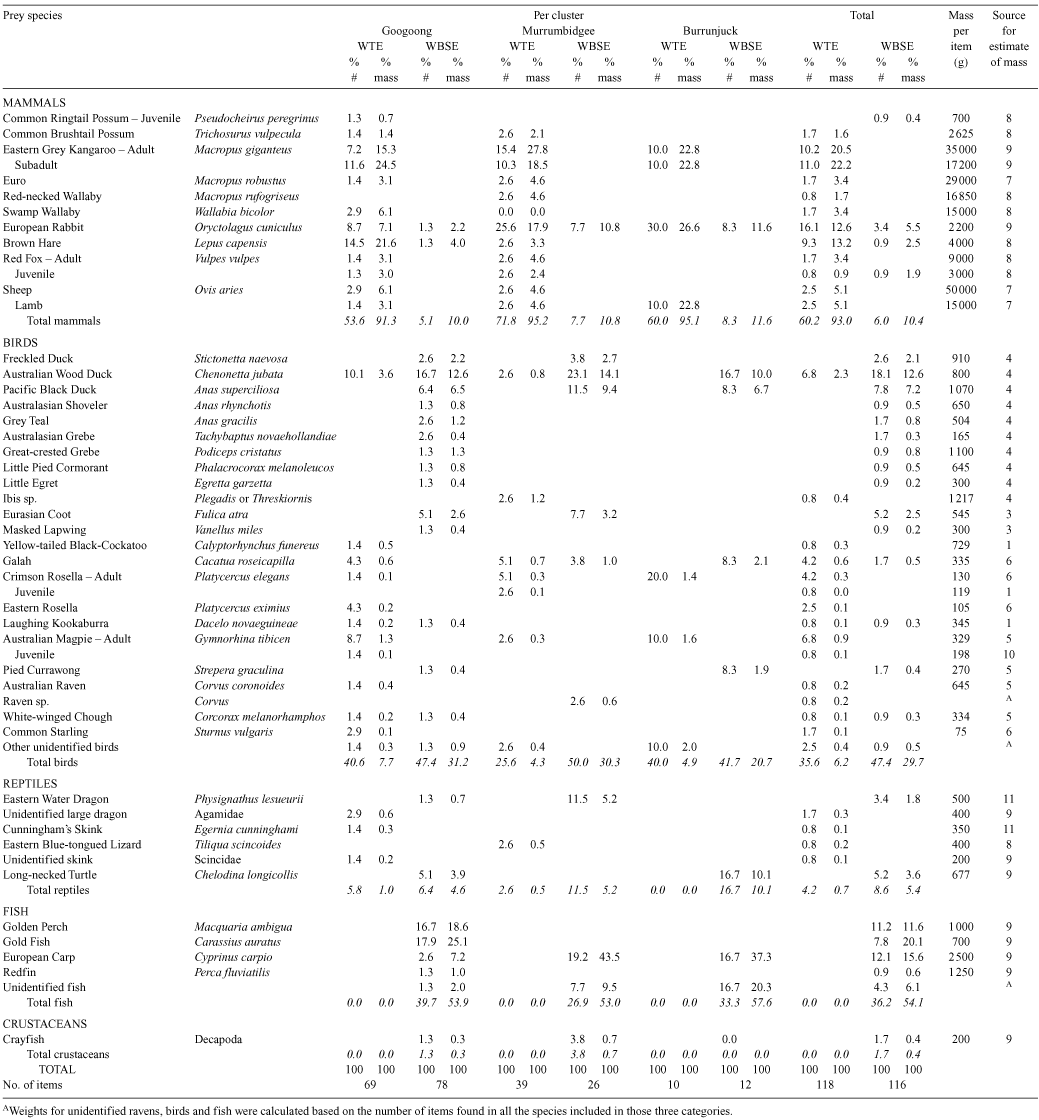Trophic relationships between neighbouring White-bellied Sea-Eagles (Haliaeetus leucogaster) and Wedge-tailed Eagles (Aquila audax) breeding on rivers and dams near Canberra
Jerry Olsen A C , Esteban Fuentes A and A. B. Rose BA Applied Ecology Research Group, University of Canberra, ACT 2601, Australia.
B Australian Museum, 6 College Street, Sydney, NSW 2010, Australia. Present address: 61 Boundary Street, Forster, NSW 2428, Australia.
C Corresponding author. Email: Jerry.Olsen@canberra.edu.au
Emu 106(3) 193-201 https://doi.org/10.1071/MU05046
Submitted: 7 September 2005 Accepted: 12 May 2006 Published: 18 August 2006
Abstract
The diet of the White-bellied Sea-Eagle (Haliaeetus leucogaster) in Australia is poorly known, especially inland. The diet of the Wedge-tailed Eagle (Aquila audax) is better known, but the overlap in prey used by the two eagles has not been studied. In four inland territories of White-bellied Sea-Eagles, and five territories of Wedge-tailed Eagles nesting close to them (range 1.6–5.1 km apart) between July 2002 and December 2004, we identified 116 and 118 prey items from nests of White-bellied Sea-Eagles and Wedge-tailed Eagles respectively. There was little overlap between the diets, and that of Wedge-tailed Eagles was similar to that reported elsewhere. In addition to fish, White-bellied Sea-Eagles specialised in aquatic birds, such as cormorants, grebes or ducks, and aquatic reptiles, such as turtles or water dragons, but tended to avoid terrestrial birds and reptiles, such as ravens and skinks, or mammals such as European Rabbits (Oryctolagus cuniculus) and macropods that were the main prey of nearby Wedge-tailed Eagles. Though food niche breadth was almost identical for the two eagles, Wedge-tailed Eagles captured significantly larger prey, as indicated by the geometric mean prey weight. Our results indicate that closely located breeding pairs of riparian Wedge-tailed Eagles and White-bellied Sea-Eagles were not competing for food, owing to the differences in foraging preferences, at least during the breeding season. We found no evidence to support the claim that the spread of rabbits assisted the increase of breeding numbers of White-bellied Sea-Eagles.
Acknowledgments
Thanks go to Terry Dennis and Jeff Jolly for generating interest in White-bellied Sea-Eagles, Nick Mooney and Les Boyd for advice, and to Christie Gould, Michael Maconachie, David Mallinson, and Frank Barnes who found Wedge-tailed Eagle nests for the larger study. Thanks also go to Tony Bell, Mark Rodden, Marty Gardner, Trish D’Abrera, Kate Boyd and Monica Muranyi for passing along their observations at Googong Foreshores, and the ACT Parks and Conservation Service, including David Shorthouse, Murray Evans, Bernard Morris, Brett Macnamara, Paul Higginbotham and Darren Rosso. Particular thanks go to Walter Boles and John Disney of the Australian Museum for aid with the identification of some specimens, and Camilla Myers for helpful editorial advice. Special thanks to Ross Bennett, Enzo Guarino, Arthur Georges, Gabriela Peniche and the Kippax Veterinary Hospital for their assistance with prey weights. EF was supported by an International Graduate Scholarship from the National Council of Science and Technology (CONACYT) in Mexico. Thanks also to Stephen Debus for advice.
Aumann, T. (2001). An intraspecific and interspecific comparison of raptor diets in the south-west of the Northern Territory Australian Wildlife Research 28, 379–393.
| Crossref | GoogleScholarGoogle Scholar |
Brooker, M. G. , and Ridpath, M. G. (1980). The diet of the Wedge-tailed Eagle, Aquila audax, in Western Australia. Australian Wildlife Research 7, 433–452.
| Crossref | GoogleScholarGoogle Scholar |
Burton, A. M. , and Olsen, P. (1997). Niche partitioning by two sympatric goshawks in the Australian wet tropics: breeding-season diet. Wildlife Research 24, 45–52.
| Crossref | GoogleScholarGoogle Scholar |
Debus, S. J. S. , and Rose, A. B. (1999). Notes on the diet of the Wedge-tailed Eagle Aquila audax. Australian Bird Watcher 18, 38–41.
Fuentes, E. , Olsen, J. , and Rose, A. B. (2005). Breeding diet at two Whistling Kite nests near Canberra. Australian Field Ornithology 22, 122–125.
Hull, C. (1986). The diet of the Wedge-tailed Eagle, Aquila audax, breeding near Melbourne. Corella 10, 21–24.
Jaksić, F. M. , and Delibes, M. (1987). A comparative analysis of food-niche relationships and trophic guild structure in two assemblages of vertebrate predators differing in species richness: causes, correlations, and consequences. Oecologia 71, 461–471.
| Crossref | GoogleScholarGoogle Scholar |
Korpimaki, E. (1987). Dietary shifts, niche relationships, and reproductive output of coexisting Kestrels and Long-eared Owls. Oecologia 74, 277–285.
| Crossref | GoogleScholarGoogle Scholar |
McDonald, P. G. , Olsen, P. D. , and Baker-Gabb, D. J. (2003). Territory fidelity, reproductive success and prey choice in the Brown Falcon, Falco berigora: a flexible bet-hedger? Australian Journal of Zoology 51, 399–414.
| Crossref | GoogleScholarGoogle Scholar |
Olsen, J. , and Tucker, A. D. (2003). A brood-size manipulation experiment with Peregrine Falcons, Falco peregrinus, near Canberra. Emu 103, 127–132.
| Crossref | GoogleScholarGoogle Scholar |
Wiersma, J. (1996). Competition between Wedge-tailed Eagles and White-bellied Sea-Eagles for nests. Australasian Raptor Association News 17, 23.

Wink, M. , Heidrich, P. , and Fentzloff, C. A. (1996). mtDNA phylogeny of sea eagles (genus Haliaeetus) based on nucleotide sequences of the cytochrome b gene. Biochemical Systematics and Ecology 24, 783–791.
| Crossref | GoogleScholarGoogle Scholar |



